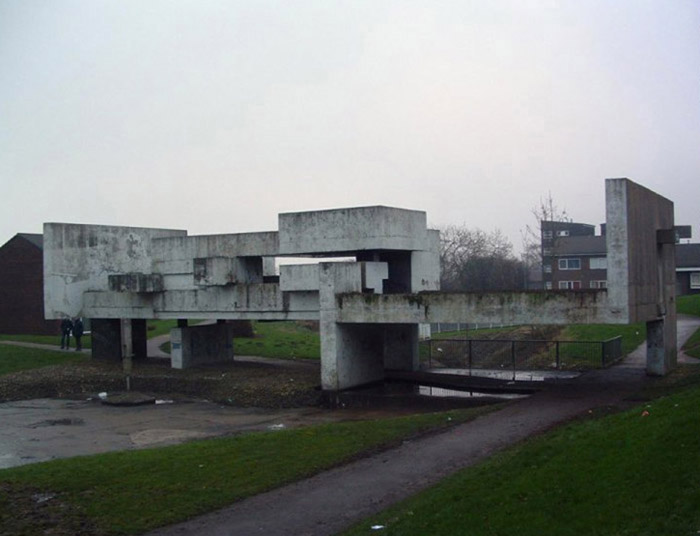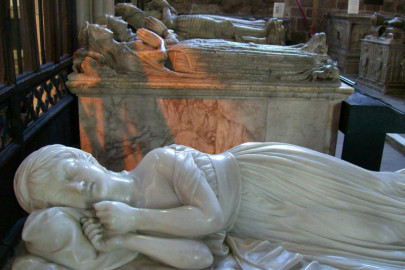Gwyn Headley, the foremost authority on English follies and co-author of the magnificent new ebook series Follies of England, looks at one of Britains most horrible listed buildings…
“Folly!” cry the locals. “Masterpiece!” cry the conservation societies. “Sod off!” cry the vandals. The Apollo Pavilion in Peterlee, County Durham, has today (15 December 2011) been listed Grade II* by English Heritage. Less than 6% of all Britain’s historic buildings reach the heights of a Grade II* listing. It is a formerly graffiti-stained bridge over nothing, designed by the fine arts professor Victor Pasmore (1908-1998) in a derivative but uncompromising concrete modernist style.
It was so persistently targeted by local saddies that only a few years ago it became a deeply scarred, deeply unpleasant environment fit only for demolition. Its sole function was as a large open air urinal. The vandals and the locals shared a healthy contempt for the cutting edge of modern architecture; but it was ever thus — although this particular cutting edge would have looked distinctly blunt had it been erected in Utrecht thirty years earlier.
The Peterlee residents were the beneficiaries or victims, depending on one’s point of view, of a brave new experiment in post-war social housing, a New Town to wash away the depression and the squalor associated with miners’ housing. The idealogical architect Berthold Lubetkin was appointed as master planner, and he assembled a team of internationally known designers and architects. Their Ville Universelle was universally applauded by architectural critics and universally hated by its residents, and the design team was riven by the dissensions and resignations only idealogues can truly enjoy — Lubetkin quit in a huff because he wasn’t allowed to build towers.
When architects describe their own creations, they frequently fall into the trap of Pollyanna optimism: the Pasmore Pavilion was designed to be ‘an architecture and sculpture of purely abstract form through which to walk, on which to linger, and on which to play.’ The structure soon became a shabby dump; English Heritage wanted to list it, Easington Council wanted to demolish it. “Nobody here wants it,” said one local thirty years after it was built. “If English Heritage wants to list it, they should take it somewhere else and list it there.” “It used to be nice when we first moved here but now it’s horrid,” said another girl. “They should knock it down.”
Access to the upper level was long blocked off. Under heavy grey skies with the wind howling through and rain lashing raw shuttered concrete it was not difficult to see this as one of the more depressing sites of ‘modern’ brutalist British architecture. You could easily smack your head walking underneath — was Pasmore a very short man? We wondered what would happen if they simply painted it and tidied it up? Instead of the drab uniformity of white paint, why shouldn’t they step back three quarters of a century to the influential inspiration of the Rietveld / Schröder Huis in Utrecht, built in 1924 when young Pasmore was at the susceptible age of 16, and paint it in the simple primary Rietveld colours of red, blue and yellow? Then see how the good people of Peterlee like it.
God, it was depressing to visit. And dangerous, and smelly too. But astonishingly enough the do-gooders won through. The Apollo Pavilion, apparently named after the moon mission when it was constructed for £33,000 in 1969, was restored in 2009 at a cost of £400,000 and won a Civic Trust Award in 2010. They didn’t go for red, blue and yellow, they chose concrete. But this is how it used to look before the restoration. I wanted to show it in its full horror.
I’d like to see it again. Perhaps from the inside of an armoured car.












As urban bling, folly it may well be, as representative art it is as accurate a facsimile of Teeside as the Piazza della Signoria is of Florence. For some years, driving down the A19 on business, the only valid reason for ever visiting the area, and cresting the hill, the vista opened up, ICI, British Steel, the eerie Transporter bridge, steaming away, mechanically brooding and doomed, like a Fritz Lang movie. In some distant future time a group of archaeological wonks, excavating with laser mattock and digital digger will proclaim “high status”
It makes an extremely important statement, it is of it’s time, major urban and social decay.
I think this is a very follyish folly, more so than most as many other follies have a point, by also being charming or lovely.
Brutalist concrete architecture brings out my inner Prince Charles.
Conceptual art is fine, as you can go to a gallery and take a quick look at some anti-human psuedo-intellectual elitist nihilistic crap and then go home again. But actually foisting on people’s landscapes or making them live in it is the worst kind of arrogance. I really hope there’s a special circle of hell for brutalist concrete architects, and that it’s made of Mock Tudor and chintz.
And don’t get me started on wind farms.
I would love to see a mock-tudor wind farm
(I also don’t like windfarms but the thought of a mock-tudor one appeals to me)
Thing is though but, it sits ‘midst an urban dung heap and fits in nicely, it blends, let it rest in peace, or knock out a few more and stick ’em in Stevenage town centre. New Cross. Where Catford dogs once stood. Kirkintilloch shopping centre. Jarrow’s Viking Precinct and the Old Kent Rd.
I like a few concrete monstrosities: the Barbican (which I used to live in), the South Bank Centre, and the Hilda Besse Building on the Woodstock Road in Oxford come to mind. I think these happen to work in a variety of ways, which most concrete buildings don’t. I also suspect one of the reasons I like them is that they provide a point of difference, a sort of concrete seasoning. They’re also becoming quite an historical curiosity – we won’t see their like again.
I remember the first time I ever came over to the USA to visit my penpal/mail amigo who at the time worked in the architecture dept at Harvard. Harvard is about as historic as America gets and many of the buildings are really very impressive. I had lunch in the ‘staff canteen’ and that was Henry James family home once upon a time. But the architecture department? That was in an ugly cube of concrete complete with shutter marks from its pouring and likely the ugliest building in Cambridge. Oh yes, and it leaked, obviously.
It doesn’t look very welcoming, but curiosity or monstrosity, I’d rather £400,000 were spent on something like this than another pointless mini-roundabout, chassis shattering speed humps, or crazy new pavement re-designs – follies of English local authorities paid for (far too often) by us fools.
Add in a few panes of glass, transformation, this one’s for sale, Euros only.
The Christian Scientists have been through a long process to be able to demolish a brutalist church at 16th and I Streets NW in Washington (which is to day two blocks from the White House). I expect that it is good of its sort, and certainly they have kept it up well. It is very unlikely that whatever replaces it will be architecturally distinguished–I expect a steel and glass box like hundreds of others here, no doubt packed with lawyers and lobbyists.
There are even rumors that the FBI finds its office building on Pennsylvania Avenue NW–another notable brutalist structure–inconvenient. I suppose it showed better thirty years ago when the neighborhood was mostly lower buildings and a bit run down. Now it is the building that looks shabby and old.